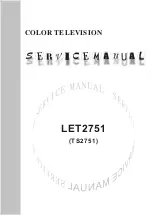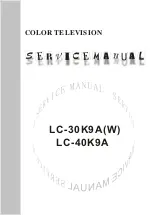
11
CONNECTING YOUR TV
E
n
g
lish
Connecting an HDMI
®
or DVI
device to the HDMI input
The HDMI input on your television receives digital
audio and uncompressed digital video from an
HDMI source device or uncompressed digital video
from a DVI (Digital Visual Interface) source device.
This input is designed to accept HDCP (High-Bandwidth
Digital-Content Protection) programme material in digital
form from EIA/CEA-861-D–compliant
[1]
consumer electronic
devices (such as a set-top box or DVD player with HDMI or DVI
output). For acceptable video signal formats, see page 85.
NOTE:
• Some early HDMI equipment may not work properly with
your latest HDMI TV, due to the adoption of a new standard.
Please unplug your HDMI cable first and then try setting the
INSTAPORT™
and
Enable Content Type
options to “
Off
”.
Your early HDMI source should operate properly with your
television. See page 73.
• Supported Audio format: Linear PCM, Dolby Digital (AC-3),
sampling rate 32/44.1/48kHz.
Connect an HDMI cable (type A connector) to the HDMI terminal.
For proper operation, it is recommended that you use an HDMI
cable with the HDMI Logo (
).
• If your HDMI connection is capable of 1080p and/or your
television is capable of refresh rates greater than 50Hz, you
will need a Category 2 cable. Conventional HDMI/DVI cable
may not work properly with this model.
• HDMI cable transfers both video and audio. Separate
analogue audio cables are not required (see illustration).
• See “HDMI 2 Audio” on page 73.
To view the HDMI device video, press the
o
button to select
HDMI 1, HDMI 2, HDMI 3 or HDMI 4 mode.
Connect an HDMI-to-DVI adaptor cable (HDMI type A
connector) to the HDMI 2 terminal and audio cables to the PC/
HDMI 2 (AUDIO) socket (see illustration).
• The recommended HDMI-to-DVI adaptor cable length is
6.6 ft (2m).
• An HDMI-to-DVI adaptor cable transfers video only.
Separate analogue audio cables are required.
• See “HDMI 2 Audio” on page 73.
NOTE:
To ensure that the HDMI or DVI device is reset properly, it is
recommended that you follow these procedures:
• When turning on your electronic components, turn on the
television first, and then the HDMI or DVI device.
• When turning off your electronic components, turn off the
HDMI or DVI device first, and then the television.
This feature enables the audio signal of the TV to be sent to the
AV amplifier via the HDMI cable. It will not be necessary to
connect a cable from the audio output of the TV to the audio
input of the AV amplifier to reproduce the audio received from
the tuner of the TV through the AV amplifier.
To connect an HDMI device
HDMI cable
HDMI device
the back of your television
To connect a DVI device
HDMI’s ARC (Audio Return Channel) feature
HDMI-to- DVI
adaptor Cable
Audio cable for HDMI to
television connection
(not supplied)
DVI device
HDMI cable
AV amplifier that supports ARC
Содержание WL76 Digital Series
Страница 1: ...WL76 Digital Series YL76 Digital Series ...












































